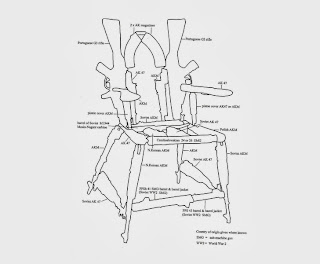The “Throne of Africa”, a sculpture on permanent exhibition at the British Museum, is also made of decommissioned dismantled guns and was created in 2001 by one of the four Mozambican sculptors, Cristóvão Canhavoto (known as Kester) who also worked on the “Tree of Life”. These weapons were previously used by combatants on both sides of that devastating civil war and were voluntarily handed over and exchanged for agricultural, domestic and construction tools.
This thought-provoking sculpture, which has been considered as the British Museum’s most eloquent object, is displayed on a plinth inside a glass case in the Introductory Room to the African Sainsbury Galleries. The guns used in its construction were manufactured in Portugal, Eastern Europe, North Korea, Germany, Poland, Czechoslovakia and Russia. In fact, the Russian contribution of the iconic AK47 rifle is important to the design, as this lethal weapon is featured on the Mozambique flag. The information label provided for this awesome sculpture includes a schematic drawing of the “Throne”, showing the identification and origin of every weapon used in its creation, therefore highlighting the dramatic and ironic connections still at work nowadays between Africa and the West in the globalised world of the 21st-century.
Precisely for the deep meaning the “Throne” carries, this was the piece chosen by the British Museum to be taken on a tour during 2005, so as to extend the message of the ‘Africa 2005’ event beyond London. In fact, this sculpture may have been shown in a wider variety of ways than any other. It was on exhibition at unexpected venues, including schools and prisons around the UK and Ireland. Several activities were fuelled around this mesmerizing and somewhat disturbing art piece, namely workshops, debates, educational projects such as recycling classes, film production or poetry workshops.





No comments:
Post a Comment